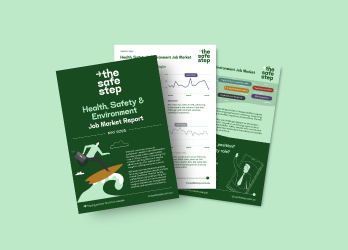HSE trends reshaping workplace safety in 2025
Page Published Date:
March 4, 2025
Your executives are pushing for AI-driven safety solutions. Your ageing workforce needs new approaches to risk management. And somewhere in between, you're tasked with protecting both the physical and psychological wellbeing of an increasingly complex workplace. Welcome to the defining HSE trends of 2025: the challenge isn't just about managing safety—it's about reimagining it for a world where technology, sustainability and human factors converge.

Technology's evolution demands human-centric safety solutions
As one of the most significant trends 2025 presents, the rise of automation, robotics and AI is reshaping workplace safety. As machines become smarter and more integrated into daily operations, the focus shifts to managing human-machine interactions effectively. This technological revolution brings fresh challenges around operational safety and worker adaptation.
Safety professionals are now at the forefront of solving complex problems as systems evolve. Success requires balancing technological advancement with human factors to create truly safe operational environments. The focus is shifting towards training workers on how to manage these new tools while maintaining safe operational boundaries.
Talent transformation underway
The workplace health and safety profession faces significant workforce challenges. Unlike more established professions, HSE lacks clearly defined career entry points and professional development pathways. Traditional entry routes are narrowing just as required skillsets are expanding. Organisations need professionals who can blend technical knowledge with emerging capabilities in communications, data analytics and human factors.
The coming years will see increased competition for these diverse skillsets. Businesses are increasingly seeking HSE professionals who can bring complementary expertise - from data analytics and AI to psychology and human factors specialisation. This broadening of required capabilities comes at a time when direct educational pathways into the profession are becoming scarcer.
The development of HSE talent requires a coordinated effort across the broader ecosystem, including professional bodies like the AIHS, employers and education providers. Without focused investment in growing talent and helping professionals adapt to emerging demands, the talent gap will only widen.
Safety leadership capability gap needs urgent attention
A concerning gap exists between leadership capability and genuine safety commitment. Some leaders still haven't fully embraced health and safety as a core organisational value, impacting culture and performance.
HSE professionals are increasingly focused on bridging this divide, working to cultivate leadership that drives the right safety and people care mindsets. Success depends on helping leaders understand how safety leadership directly influences organisational success and bottom-line outcomes.
Mental health takes centre stage
Mental health has moved beyond basic awareness to become a critical component of comprehensive safety strategies. Boards and executives are now tackling psychological risks head-on, implementing robust support programs and fostering psychologically safe workplaces. This shift towards "whole person" wellbeing marks a significant evolution in workplace safety thinking.
While progress is encouraging, there's still ground to cover. Leading organisations are strengthening their mental health initiatives and creating sustainable, long-term support systems that benefit all employees. The key lies in moving from reactive measures to proactive wellbeing strategies.
Navigating demographic shifts
Australia's ageing workforce presents unique challenges, particularly in construction, manufacturing and agriculture. This demographic change demands a reimagining of workplace safety through a more human-centric lens.
Safe work practices must evolve to address the different physical and mental needs of older workers. This includes enhanced injury prevention strategies and innovative workplace design solutions. The most successful organisations are those creating flexible approaches that support workers across all age groups.
Evolving HSE governance landscape
Legal frameworks around Health and Safety continue to strengthen, with increased penalties for non-compliance. Rising workers' compensation claims and enforcement pressures are pushing organisations toward higher safety standards.
The challenge for HSE professionals lies in balancing compliance requirements with more progressive approaches to safety performance. Progressive organisations are moving beyond traditional metrics to develop more meaningful indicators of safety success.
Sustainability meets safety
The Environmental and Social Governance (ESG) agenda is further broadening the scope of workplace risk management. Environmental health and safety is merging with sustainability efforts, creating opportunities for HSE professionals to expand their influence and expertise.
This integration demands new skills and knowledge around "greener" work practices, from reducing hazardous material exposure to managing climate-related impacts. For forward-thinking safety professionals, this represents an exciting career growth opportunity.
How specialist recruitment partnership drives success
These evolving challenges demand fresh thinking about how you build and maintain your HSE capability. Whether you're implementing new safety technologies, managing succession planning or transforming your approach to wellbeing, having the right expertise at the right time is crucial.
The Safe Step brings more than just recruitment expertise. Our temporary staffing solutions provide the extra capacity you need to tackle major projects. Our recruitment consultants help you build teams with the emerging skillsets these trends demand. And our strategic advisors work alongside you to uplift capability and solve complex safety challenges. All of this is underpinned by deep cross-sector insights that ensure you benefit from best practices and emerging approaches across industries.
Looking ahead with confidence
These workplace safety trends 2025 may present challenges, but they also bring opportunity. By understanding these trends and investing in the right capabilities, you can create safer, more sustainable workplaces that benefit everyone. The future of workplace safety starts with the decisions you make today.




